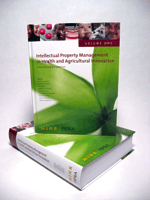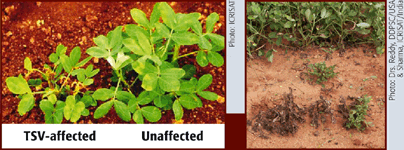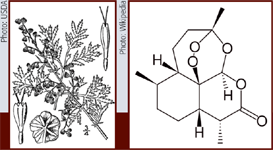
Why Does Intellectual Property Management Matter for the Public Sector?
By Anatole Krattiger
Anatole Krattiger is a Research Professor at the Biodesign Institute at Arizona State University, and an Adjunct Professor at Cornell University. This article is loosely based on an editorial he published in Intellectual Property Management in Health and Agricultural Innovation: A Handbook of Best Practices (eds. A Krattiger, RT Mahoney, L Nelsen, et al.), published by MIHR: Oxford, U.K., and PIPRA: Davis, U.S.A.
Almost every country around the world updated and revised its laws related to intellectual property (IP) rights over the last decade or so. Nearly every bilateral trade agreement includes IP clauses. As stated by WIPO Deputy Director Francis Gurry in his foreword to Intellectual Property Management in Health and Agricultural Innovation: A Handbook of Best Practices a true “explosion of IP legislation at the international level” has occurred with ten new multilateral IP treaties having been concluded in the last 15 years alone1. It is not surprising therefore that IP rights are often viewed as something complicated and controversial. Because of its feared impact on low- and middle-income countries, the most discussed treaty in the context of health research and development has been the Agreement on Trade-Related Aspects of Intellectual Property Rights (TRIPS). Whether or not, and to what extent, TRIPS will impact the pricing and availability of health and agricultural innovations, are certainly legitimate concerns. But access to health and agricultural products depends on many factors.

The Handbook recognizes that IP rights are sometimes viewed as creating barriers to access to innovations in health and agriculture, but argues that it is not IP per se that raises barriers, but rather how IP is used and managed, particularly by public sector institutions (such as universities, national research institutions, and non-profit organizations). The Handbook discusses all major aspects of IP management but views IP management as but one of six closely connected and inter-related components of innovation. And intellectual property is rarely the most important. Efforts to meet the needs of the poor must also:
- support R&D;
- adopt policies and develop safe and effective regulatory systems (for drug and vaccine registration; biosafety and food safety for applications of biotechnology in food, feend fiber; and seed quality certifications);
- encourage high-quality manufacturing of drugs and vaccines and investments in high-quality seed production and that of other agricultural inputs;
- develop national health programs and agricultural extension systems that are sustaining domestic markets, including distribution systems in both the public and private sectors; and
- be conducive to facilitating trade in health and agricultural products and technologies.
Indeed, much of the impact of TRIPS, for example, will depend on how countries and institutions respond five components of innovation listed above, in addition to the evolving IP regime. There is every indication that IP management skills appear to be one of the crucial elements for harnessing the positive potential of TRIPS, and mitigating the negative ones, and such skills will allow developing countries to gain access to emerging tools, technologies, and resources that can dramatically improve the health and welfare of their citizens. For example, private industry in India is not automatically channeling its resources into the R&D of drugs for diseases that dominate in developing countries; instead, it is focusing on robust markets for new health technologies in developed countries. Therefore, in India the public sector should advance health solutions for diseases that predominantly afflict the poor, focusing on innovations that could eventually be brought to market by the private sector. Effective IP management can allow public research institutions to use their own research products to benefit the poor and to enter into public-private partnerships that can direct the power of industry to the needs of the poor. Without knowledge of sophisticated IP management techniques, however, such efforts—and their benefits—will be impossible.
Similarly, each country needs to take advantage of the freedoms granted by TRIPS and formulate and implement policies and practices that best meet its own needs. Short-cut solutions to technology needs in medicine and health, such as compulsory licenses, are unlikely to be as effective or sustainable as are collaborative efforts between the public and private sectors. Countries would benefit substantially from developing their internal IP management capabilities, strengthening their IP court systems and patent offices, and according priority to meeting the needs of the poor.
Hence the evolving global IP regime should not merely be seen as an evolution in laws and legislation; rather, IP rights are, first and foremost, about the encouragement of investments in innovation. Second, the IP rights systems were created to regulate access to and sharing of intellectual property. IP rights, therefore, are not primarily about preventing others from using ones intellectual property, but IP rights are strategic tools to determine the best course of action to get intellectual property used. Unless intellectual property “finds” its way into the marketplace, it is useless. And the marketplace can be commercial or humanitarian.
With sound strategies and best practices in IP management, the public sector in particular has tremendous power to put intellectual property to work as a component of a broader strategy aimed at accelerating access—especially access by developing countries—to life-saving and poverty-alleviating innovations in health and agriculture. IP management is an essential element in the quest for a more equitable world, especially when seen as a tool to be used for public sector goals and by the public sector. Unfortunately, the historical trend has been for intellectual property to benefit mostly the affluent. This is due, in part, to the fact that insufficient attention has been paid by the public sector to managing intellectual property. This lack of focused attention must be corrected. Public sector IP management is a rather young discipline, and there have been enormous changes in the public sector’s involvement in health research since the 1970s and in agri-biotechnology since the 1990s. But the public sector is only now beginning to appreciate how it can use its own intellectual property—and leverage that of others—to help meet its social mission, including its responsibilities to the poor. With growing interest within both the public and private sectors in using intellectual property for public benefit has come the realization that the public sector lacks knowledge and capacity to put intellectual property to work. The Handbook is designed to help address these needs together with many initiatives of WIPO and other institutions.
Surely, IP rights are an imperfect solution and a compromise. They represent the search for balance between making all knowledge freely available within the public domain and granting ownership of valuable discoveries to the inventors. Historically, we have seen that this balance encourages investment—and reinvestment—in innovation, although this innovation too infrequently is directed toward the needs of the poor. Reaching an appropriate balance requires continuous, sound IP management, and fortunately, numerous case studies have shown that the public sector can craft effective solutions that can achieve, or at least approach, a suitable balance. This can be accomplished by using the existing IP system, especially as it addresses situations in which companies agree to donate or otherwise share their intellectual property. But the approach requires a fundamental reconceptualization of what IP rights are for and how they can be used by the public sector.
When it comes to increasing developing countries’ access to fundamental innovations in health and agriculture, success requires knowledge, capacity, active engagement, and strategic management of intellectual property by the public sector. This should be coupled with improved institutional IP management capabilities, the formulation of comprehensive national IP policies, and the strengthening of IP court systems and patent offices. This is what best practices in IP management are all about: promoting public welfare—especially those people who have, until now, been unable to partake in technology’s benefits—and that this will contribute to building a healthier and more equitable world.
| Case Study: India’s Groundnut Program | |||||||||||||||
|---|---|---|---|---|---|---|---|---|---|---|---|---|---|---|---|
|
In agriculture, a recent example involves Agricultural Biotechnology Support Project II (ABSPII), the International Crops Research Institute for the Semi-Arid Tropics (ICRISAT), Acharya N. G. Ranga Agricultural University (ANGRAU) in India, and Sathguru Management Consultants (Sathguru), also of India, with licenses from the Donald Danforth Plant Science Center (the Danforth Center) and Monsanto Company, both in St. Luis, USA. The project deals with groundnut, or peanut, which is a staple oilseed crop grown for food and for forage in India. It is cultivated on a vast 7.5 million hectares in India with annual production of about 8 million tons. More than 5 million small-scale and marginal farming families depend on this crop for their viability. A new virus emerged that caused more than US$65 million in losses and seriously threatening the livelihoods of farmers. Yet food biotechnology applications have demonstrated elsewhere that the devastating disease can be prevented with proven coat protein (CP) technology. ABSP II therefore brokered a project, described in Table 2, which is leading to the development of virus-resistant groundnut for small-scale farmers, initially in India, and subsequently in neighboring countries as well. Table 2: Key license terms of the Groundnut Program involving ABSPII, ICRISAT, ANGRAU, Sathguru, the Danforth Center, and Monsanto Company2
|
| Case Study: Reducing cost for Malaria treatment | ||||||||||||
|---|---|---|---|---|---|---|---|---|---|---|---|---|
|
In the are of health,the Institute for OneWorld Health (iOWH) , a nonprofit entity, created a unique three-way partnership between iOWH, the University of California (UC) at Berkeley, and Amyris Biotechnologies, Inc. (a UC spinout company). The goal of this project is to significantly reduce the cost of artemisinin, a key precursor in the production of Artemisinin Combination Therapies (ACT), through synthetic biology, industrial fermentation, and chemical synthesis. Artemisinin is chemically converted to one of several derivatives and then combined with other drugs to make an ACT for the treatment of malaria. Malaria inflicts as many as 500 million people annually of which 1.5 million people die each year, primarily children in Africa and Asia. Studies in Vietnam have shown that the botanically derived medicine, artemisinin derivatives, can reduce deaths from the illness by 97 percent. However, the current cost of a three-day course of drugs containing artemisinin is US$2.40, which places it out of reach for people in many nations where the disease is most prevalent. For this reason, the Bill and Melinda Gates Foundation funded the project to eliminate the need for plant extraction by utilizing a synthetic biology platform technology. UC Berkeley continued with basic research, Amyris conducts applied research on the fermentation and chemical processes, and iOWH performs the required regulatory work, leads the implementation of the product development strategy for the developing world, and develops a commercialization strategy based on a thorough understanding of the worldwide regulatory requirements and an analysis of the current manufacturing supply-chain and distribution models. To ensure accessibility and affordability, the partners have committed to reduced returns in the malaria field with creative licensing arrangements that will make the product available to the developing world at the lowest possible price. The specific terms are described in Table 1. This arrangement has benefits for all the parties: the university benefits from the research funding as well as from any royalties that may be realized on profit earned from sales by Amyris in areas outside the developing world; as a for-profit company, Amyris can apply the innovations developed for the artemisinin project to other projects that rely on the same platform technology; as a non-profit, iOWH is able to make malaria treatments more affordable for people in the developing world which constitutes one of its mission.
Table 1: Key license terms of the UC Berkeley, iOWH and Amyris agreement for the production of Artemisinin Combination Therapies (ACT) for Developing Countries3
|
_________________
1. These are: Madrid Protocol (1989), Washington Treaty on Integrated Circuits and the Film Register Treaty (1989), UPOV 1991 Act (1991), TRIPs (1994), Trademark Law Treaty (1994), WIPO Copyright Treaty, WIPO Performances Treaty (1996), WIPO Phonograms Treaty (1996), Geneva Act of the Hague Convention (1999), and the Patent Law Treaty (2000).
2. Medakker A and V Vijayaraghavan. 2007. The Groundnut Story: A Public-Private Initiative focused on India. Case Study 2. In Executive Guide to Intellectual Property Management in Health and Agricultural Innovation: A Handbook of Best Practices (A Krattiger, RT Mahoney, L Nelsen, etal.). MIHR: Oxford, U.K., and PIPRA: Davis, U.S.A. Page CS9.
3. Source: MIHR/PIPRA. 2007. Improved Production of a Natural Product Treatment for Malaria: OneWorld Health, Amyris, and the University of California at Berkeley. Case Study 20. In Executive Guide toIntellectual Property Management in Health and Agricultural Innovation: A Handbook of Best Practices (eds. A Krattiger, RT Mahoney, L Nelsen, etal.). MIHR: Oxford, U.K., and PIPRA: Davis, U.S.A. Page CS46.
The WIPO Magazine is intended to help broaden public understanding of intellectual property and of WIPO’s work, and is not an official document of WIPO. The designations employed and the presentation of material throughout this publication do not imply the expression of any opinion whatsoever on the part of WIPO concerning the legal status of any country, territory or area or of its authorities, or concerning the delimitation of its frontiers or boundaries. This publication is not intended to reflect the views of the Member States or the WIPO Secretariat. The mention of specific companies or products of manufacturers does not imply that they are endorsed or recommended by WIPO in preference to others of a similar nature that are not mentioned.

